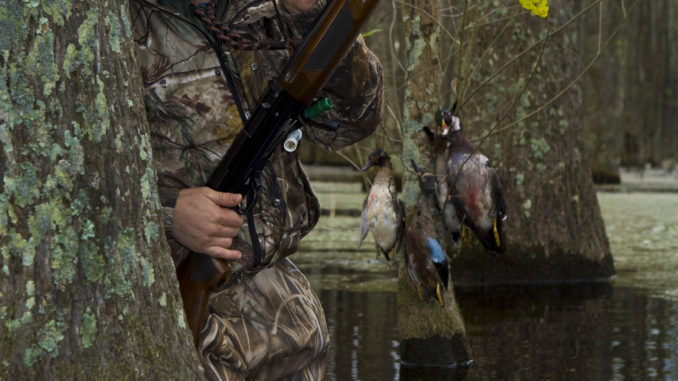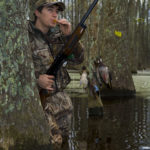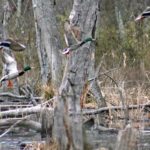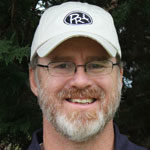
A little cover and a few decoys can make for a great small-water duck hunt across South Carolina
The morning mist lifted off the still water as the sun began to peek over the horizon. Soft ripples revealed a beaver returning to his lodge. Three hunters were standing in knee-deep, icy cold water in a honey hole of flooded timber of a beaver pond on an unnamed tributary of Lake Greenwood. Ducks that thrive along the lake know the area and dive in at first light to begin day of feeding.
Typical to South Carolina, wood ducks showed up first, darting and diving through the timber and alighting right in front of the hunters. Careful not to make their presence known, they waited patiently for legal shooting light before the serenade began. Just as the clock struck official sunrise, a shotgun barked and the first drake woody fell, then chaos ensued. Ducks coming into the timber were turning to leave, others already there desperately tryied to escape. Within minutes, a limit of woodies was in the bag.
Marshall French of Sumter knows how to fill a limit of ducks on small bodies of water. Growing up in Laurens, he honed his skills along the Reedy River and Lake Greenwood and its many tributaries. This whole area is covered in beaver ponds; it often seems that every creek, stream or branch that flows into a major river and the lake has beaver ponds on them. These ponds can be the “promised land” for duck hunters who prefer out-of-the-way locations, but hunting these ponds is very different than hunting bigger bodies of water.
“With these smaller bodies of water, less is more. Too many hunters put way too many decoys out and call too often,” said French, who believes you need to gear your hunting to the size of the area you’ve chosen. “I will typically use no more than eight decoys (mallards and drake wood ducks) in these areas.
“There is really no rhyme or reason to the pattern here; the typical ‘J’ or ‘V’ set-up isn’t necessary because of the timber. But if the area is more open, then I may use the ‘J’ style set-up with my decoys. Trying to force the ducks into the opening of the pattern will put them right at the end of your gun barrel.”
Perhaps the greatest asset a small-water hunter can carry is a bobble decoy or bobble disk. A small “feeding” duck that has a battery-operated gyro that causes the tail to wobble, it can and often does make all of the difference.
“When ducks are circling above and they see that movement of a feeding duck, they will — more often than not — commit and come on in,” French said. “This little device has led to the demise of many a duck since I discovered it several years ago.
“Using the spinning-wing decoys in these small ponds often has the opposite effect; it just has too much flash and seems to scare them off. Remember, ‘Less is more’.”
Getting to and setting up in these places is often a logistical nightmare. Some can be accessed by foot; others require some sort of water conveyance. But one thing they have in common is, beaver-pond ducks fly early — usually well before legal shooting light. A hunter arriving late will often spoil the whole event. When hunting these ponds, allow time for walking through often very muddy areas, where each step sinks past your knees. Carry a good light, and if possible, know in advance where you want to set your blind. Be in your spot and have your decoys out at least an hour before legal shooting time arrives.
One advantage these areas have for hunters is there is usually plenty of standing timber or tall cane that can quickly be converted into some sort of cover. Using pruning shears, you can easily build a makeshift blind, especially when cane is available. One advantage of using cane is it is very flexible and will flex out of your way when swinging your gun.
To improve your odds of where to set up, in what is often a maze of swamps, standing water and flowing water. French suggests putting in some scouting before the season opens.
“I hunted the same beaver pond opening day for several years and always scouted for the best location,” he said. “A few years ago, I didn’t take the time to scout and went to one of my older blinds. As luck would have it, when I showed up to hunt, the ducks were using a new addition to the pond a hundred yards up stream. The whole day was a bust.”
Scouting can be as simple as driving up or walking up and looking for ducks, paddling through and flushing them or checking throughout the day for ducks resting. But it is always a good use of your time to take a moment and scout ahead of your hunt.
One thing that is noticeably different with small bodies of water is that ducks will either be calm and tolerant or quite skittish. They will commit quickly and enthusiastically — or totally ignore your setup; there seems to be no in between. Experience teaches, however, that when ducks seem skittish and unwilling to commit, something is usually wrong with the set-up. It might be too tight to cover, leaving no good landing areas, or a hastily constructed blind might give away a hunter’s location. Use the old trappers’ logic: “If you aren’t bringing them to your location, let them show you why.” The ducks will usually let you know if they like your set-up.
Typical to South Carolina duck hunting, wood ducks show up first. When this frenzy is over, and either limits are filled or the ducks are gone, patience is the key. While some ducks use these out of the way ponds for feeding, others use them for mid-day resting; this seems especially true of the bigger ducks.
Beginning a few hours after sunrise, mallards will often begin to show up in pairs or groups of a half dozen. Calling to them is a delicate proposition. Here too, less is more.
“When calling to these ducks there is never a reason to blow hard and excessive,” French said. “Let them know you are there, and they will come.”
Many of these places are not well-known to hunters; that’s is one of the reason they are so attractive. A little leg work is needed to find a good location, but fortunately, today’s technology makes them easier to find. Google Earth and other aerial-mapping software are great tools at finding small bodies of water; scouting from home will save a lot of time looking, especially since most are totally hidden from view from the main water.
While there are some bodies of water on the right of way of these lakes and rivers, many are on private land, so permission should be sought before going into many of these.
“I try and find the ones that are near the backwater of the lakes and rivers. Most of these are definitely public domain or part of a WMA,” French said.
Another draw to these small locations is the variety of ducks that can be encountered. French says he has killed many different species of ducks at the same hole: wood ducks, mallards, gadwalls, widgeon, teal, bufflehead and even the occasional pintail will show up in these beaver ponds.
Without question, some of the finest duck hunting can be had on smaller bodies of water, and this makes them far more accessible to the average hunter who may not have 15 dozen decoys or a boat dedicated to watefowl hunting. The ability to walk in, throw out a half-dozen decoys and be in business makes for enjoyable hunting. So do some leg work, look about and find these hideaways for great gunning and some exciting wing shooting.






Be the first to comment